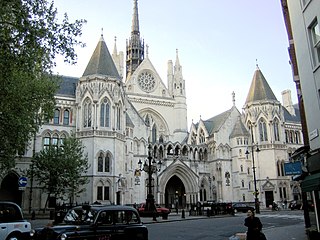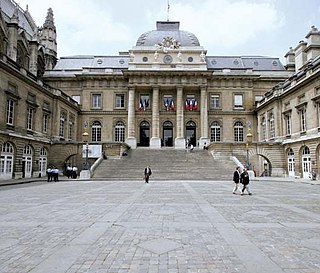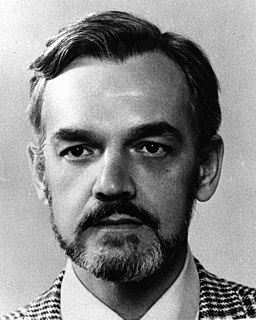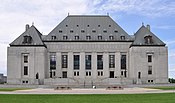
The Court of Appeal is the highest court within the Senior Courts of England and Wales, and second in the legal system of England and Wales only to the Supreme Court of the United Kingdom. The Court of Appeal was created in 1875, and today comprises 39 Lord Justices of Appeal and Lady Justices of Appeal.

The Supreme Court of Canada is the highest court of Canada, the final court of appeals in the Canadian justice system. The court grants permission to between 40 and 75 litigants each year to appeal decisions rendered by provincial, territorial and federal appellate courts. Its decisions are the ultimate application of Canadian law and binding upon all lower courts of Canada, except to the extent that they are overridden or otherwise made ineffective by federal or provincial legislation.
In law, a judgment, also spelled judgement, is a decision of a court regarding the rights and liabilities of parties in a legal action or proceeding. Judgments also generally provide the court's explanation of why it has chosen to make a particular court order.

The Court of Cassation is one of the four courts of last resort in France. It has jurisdiction over all civil and criminal matters triable in the judicial system, and is the supreme court of appeal in these cases. It has jurisdiction to review the law, and to certify questions of law, to determine miscarriages of justice. The Court is located in the Palace of Justice in Paris.
In law, an en banc session is a session in which a case is heard before all the judges of a court rather than by one judge or a panel of judges selected from them. The equivalent terms in banc, in banco or in bank are also sometimes seen.
Claire L'Heureux-Dubé served as a puisne justice on the Supreme Court of Canada from 1987 to 2002. She was the first woman from Quebec and the second woman appointed to this position, after Bertha Wilson. Previously, she had been one of the first woman lawyers to handle divorce cases, and was the first woman appointed as a judge to the Quebec Superior Court and the Quebec Court of Appeal.
A puny or puisne justice is a dated term for an ordinary judge or a judge of lesser rank of a particular court.
The court system of Canada forms the judicial branch of government, formally known as "The Queen on the Bench", which interprets the law and is made up of many courts differing in levels of legal superiority and separated by jurisdiction. Some of the courts are federal in nature, while others are provincial or territorial.
Ronald Martland, was a Canadian lawyer and Puisne Justice of the Supreme Court of Canada. He was the second Albertan appointed to the Supreme Court of Canada, taking the place of Justice Nolan, who died after only a short time on the Court.

Jean-Marie Philémon Joseph Beetz,, c.r. was a Canadian lawyer, academic and judge from Quebec. He served as a puisne justice of the Supreme Court of Canada from 1974 to 1988.

The Supreme Court of Virginia is the highest court in the Commonwealth of Virginia. It primarily hears direct appeals in civil cases from the trial-level city and county circuit courts, as well as the criminal law, family law and administrative law cases that are initially appealed to the Court of Appeals of Virginia. It is one of the oldest continuously active judicial bodies in the United States. It was known as the Supreme Court of Appeals until 1970, when it was renamed the Supreme Court of Virginia because it has original as well as appellate jurisdiction.
A dissenting opinion is an opinion in a legal case in certain legal systems written by one or more judges expressing disagreement with the majority opinion of the court which gives rise to its judgment. When not necessarily referring to a legal decision, this can also be referred to as a minority report.

The Supreme Court of the Republic of Singapore is one of the two tiers of the court system in Singapore, the other tier being the State Courts.

The Court of Appeal of the Republic of Singapore is the nation's highest court and its court of final appeal. It is the upper division of the Supreme Court of Singapore, the lower being the High Court. The Court of Appeal consists of the Chief Justice of Singapore, who is the President of the Court, and the Judges of Appeal. The Chief Justice may ask judges of the High Court to sit as members of the Court of Appeal to hear particular cases. The seat of the Court of Appeal is the Supreme Court Building.

R v Swain, [1991] 1 S.C.R. 933 is a leading constitutional decision of the Supreme Court of Canada on certain rights of the mentally ill in their criminal defence. The case concerned a constitutional challenge of the common law rule permitting the Crown to adduce evidence of an accused's insanity and section 542(2) of the Criminal Code, which allowed for the indeterminate detention of an accused who is found not guilty by reason of "insanity". The Court held that both the common law rule and the Code provision were unconstitutional. As a result, the Court created a new common law rule that was constitutional, and Parliament created new laws of what to do with individuals who were found not criminally responsible by reason of a mental disorder. The parties to the case were the appellant, Swain, the respondent, the Crown, and the following interveners: the Attorney General of Canada, the Lieutenant Governor's Board of Review of Ontario, the Canadian Disability Rights Council, the Canadian Mental Health Association, and the Canadian Association for Community Living.

The Montana Supreme Court is the highest court of the Montana state court system in the U.S. state of Montana. It is established and its powers defined by Article VII of the 1972 Montana Constitution. It is primarily an appellate court which reviews civil and criminal decisions of Montana's trial courts of general jurisdiction and certain specialized legislative courts, only having original jurisdiction in a limited number of actions. The court's Chief Justice and six Associate Justices are elected by non-partisan, popular elections. The Montana Supreme Court meets in the Joseph P. Mazurek Building in Helena, Montana, the state's capital, an international style building completed in 1982 and named in the honor of former Montana Attorney General, Joseph P. Mazurek.

Hans Raj Khanna was an Indian judge, jurist and advocate who propounded the basic structure doctrine in 1973 and upheld civil liberties during the time of Emergency in India in a lone dissenting judgement in 1976. He entered the Indian judiciary in 1952 as an Additional District and Sessions Judge and subsequently was elevated as a judge to the Supreme Court of India in 1971 where he continued till his resignation in 1977.
A judicial opinion is a form of legal opinion written by a judge or a judicial panel in the course of resolving a legal dispute, providing the decision reached to resolve the dispute, and usually indicating the facts which led to the dispute and an analysis of the law used to arrive at the decision.

Thomas Albert Cromwell is a Canadian jurist and former Puisne Justice on the Supreme Court of Canada. After eleven years on the Nova Scotia Court of Appeal, Cromwell was nominated to succeed Michel Bastarache and occupy the seat traditionally reserved for Atlantic provinces on the Supreme Court of Canada by Prime Minister Stephen Harper,. and assumed office on December 22, 2008. Cromwell retired in September 2016, and was succeeded by Malcolm Rowe.

The New South Wales Court of Criminal Appeal, part of the Supreme Court of New South Wales, is the highest court for criminal matters and has appellate jurisdiction in the Australian State of New South Wales.











